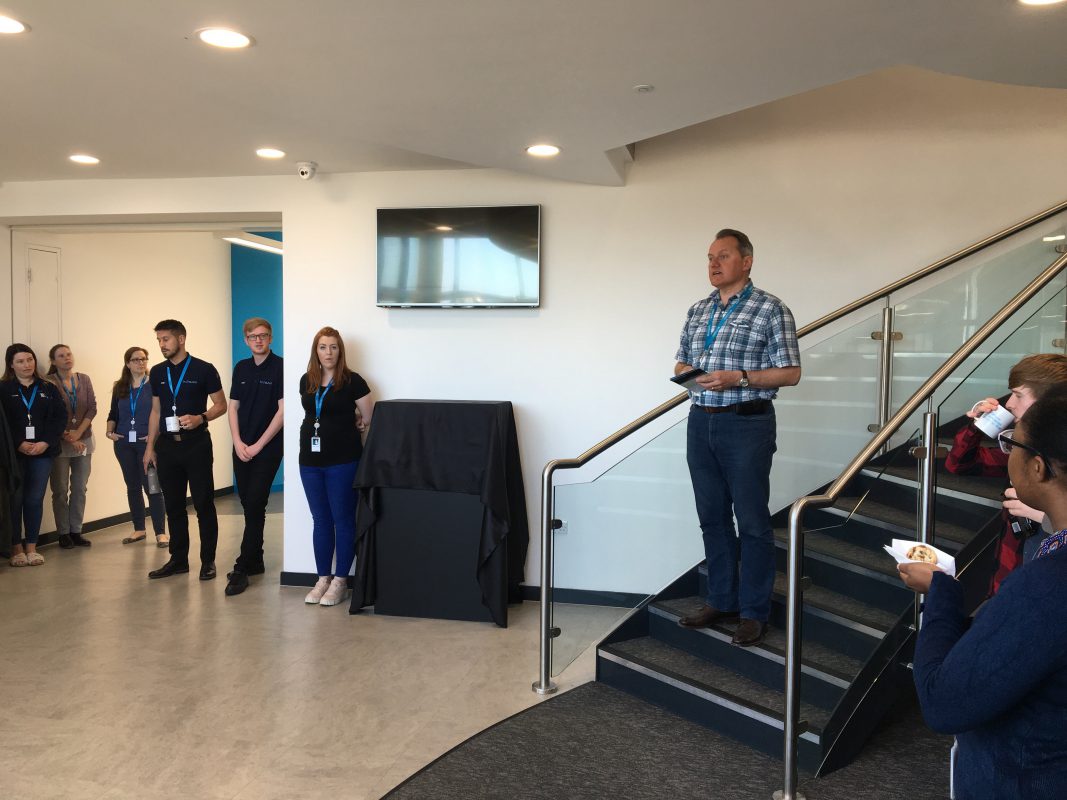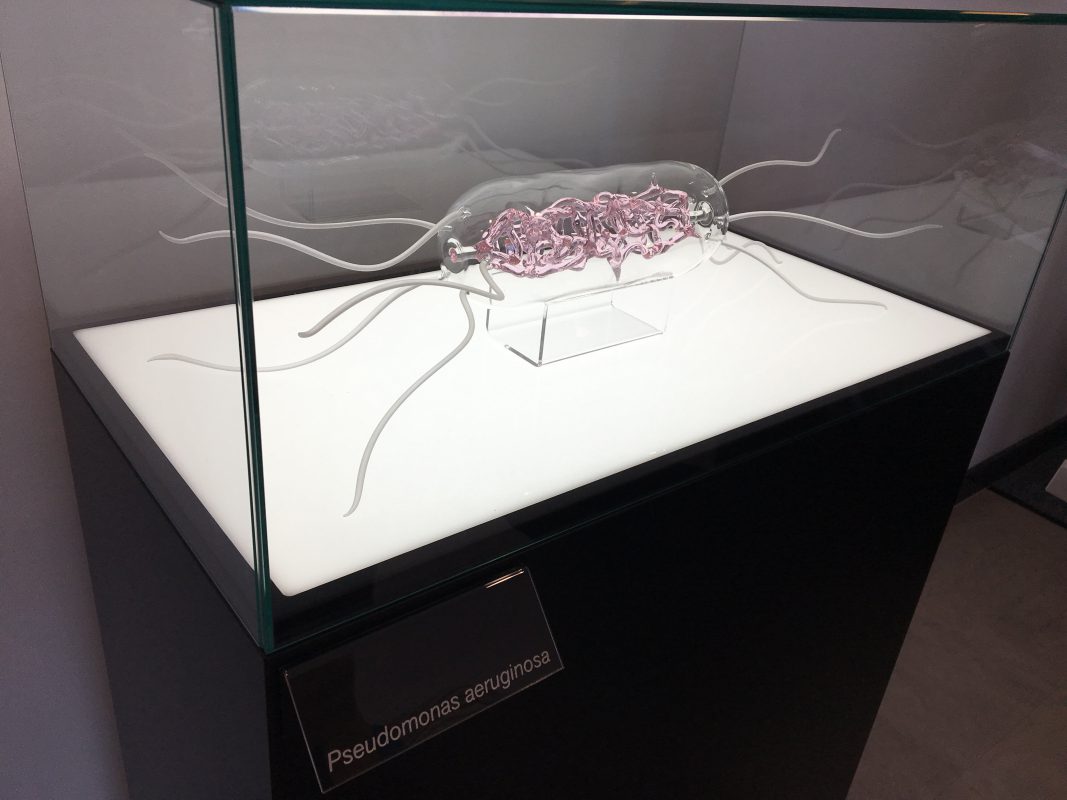Glass Microbiology Sculptures unveiled at Bath ASU HQ
We have been privileged to unveil four glass microbe sculptures in our Bath ASU HQ reception, created by artist Luke Jerram, to help give us a daily reminder to be vigilant in eradicating these microbes from our processes and products.
Every day of our working lives we strive to control the presence of non-viable particulate and microbial contamination in our production environment and in doing so eradicate these twin evils from our products. A particle is something you can see, microbes remain invisible. Whilst these enemies remain invisible, visualising and focusing our efforts on combatting them is challenging. They become all too easily dismissed or ignored as a threat.
These sculptures are intended to make these microbes visible, to give us a daily reminder of their presence in order that we maintain our vigilance in eradicating them from our processes and products. To move in or out of the building is to now move amongst them.
We are quite literally placing them on a pedestal to force us to respect them as an adversary and not dismiss their challenge to our product quality. We have made them beautiful to help us remember them. They have been around for billions of years, much longer than us. They will no doubt be around longer than we will be, just not in our products.
– Chris Watt CEO QPHL
About The Artist
Luke Jerram has created a number of extraordinary art projects which have excited and inspired people around the globe. Luke Jerram’s practice involves the creation of sculptures, installations, and live art projects. He is the Leverhulme Trust Artist in Residence at the University of Bristol. Further information on Jerram’s entire practice can be found at lukejerram.com.

Micrococcus luteus
First discovered by Alexander Fleming (who discovered the antibiotic penicillin).
The term Micrococcus is derived from Greek: “mikros” meaning “small”, “kokkos” meaning “grain/seed” and luteus comes from Latin, and means “golden yellow”, which is the colour of this bug when grown in the lab.
Why is this bug important to us?
In patients with compromised immune systems, such as those with HIV or undergoing chemotherapy, Micrococcus luteus can cause infections such as septic shock, meningitis and pneumonia.
It can be found living on human skin and in dust, and is one of the organisms which is most commonly recovered from settle or contact plates which have been in the clean room. Contamination of our products with this bacterium could have potentially serious consequences for patients, which is why we work so hard to keep a sterile environment during the manufacturing process.
This bacterium can be killed using bleach and alcohol spray.
It’s not all bad…
Currently being investigated for its ability to absorb UV radiation, which could lead to the development of better sun cream.

Pseudomonas aeruginosa
The word Pseudomonas comes from the Greek “pseudo” meaning “false” and the Latin “monas” meaning “a single unit”. The term “mon” was used by early microbiologists to refer to germs. The word “aeruginosa” is a Latin word which means “copper rust”, and refers to the blue-green colour of the bug when grown in the lab.
Why is this bug important to us?
This bug causes hospital-acquired infections including pneumonia, septic shock and gastrointestinal infection (stomach bug) and is now resistant to multiple different antibiotics, making it very difficult to treat. It is very common in the environment and is a serious cause for concern if found in a clean room.
This bacterium can be killed using bleach and alcohol spray.
It’s not all bad…
Previously species of Pseudomonas have been studied for its potential use in bioremediation, which means using bacteria to clean up dangerous environmental pollution.

Aspergillus brasiliensis
The name Aspergillus is derived from the Latin “aspergillum” which means “holy water sprinkler”, after their shape as viewed through a microscope.
Why is this fungus important to us?
It is a common cause of black mould in the environment and can in rare cases cause serious lung disease aspergillosis. It also forms spores which are resistant to destruction and are able to persist in the environment for a very long time. Once an environment is contaminated with a mould like this it is very difficult to get rid of, which would cause considerable problems in our clean room environment.
Aspergillus spores are very difficult to get rid of, and cannot be killed by bleach and alcohol spray. This is why it is imperative to change into clean, sterile clothes and to ensure that hands are thoroughly washed and hair is covered before entering the clean room.
It’s not all bad…
Aspergillus brasiliensis is commonly used in the food industry to manufacture citric acid and gluconic acid and can be fermented to produce pectinases which are used in cider and wine clarification.

Candida albicans
The name Candida is from the Latin for canididus which means “white” and albicans from the Latin word albico which means “becoming white”
Why is this fungus important to us?
This organism is a yeast which can be found in 40% to 60% of the gastrointestinal tract of human beings. It is usually a harmless organism but in those that are immunocompromised, it can lead to an infection called candidiasis – an overgrowth of the yeast. This infection kills up to 40% of humans.
Candida spp is the most common organism found in biofilms on infected tissue and on implanted medical devices.
If Candida is found in the clean room, it is an indication of a loss of control of the environment and an indicator of poor hygiene practices.
It’s not all bad…
Candida is used as a supplement in feed for livestock due to its high protein content and availability.
